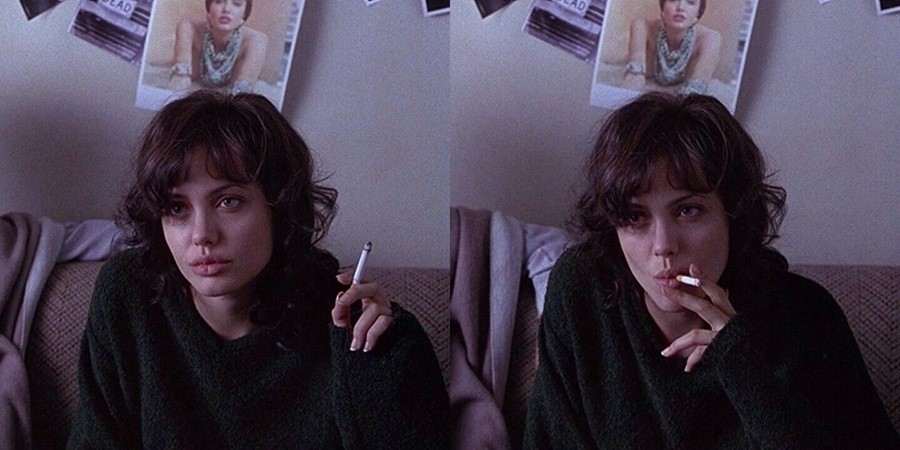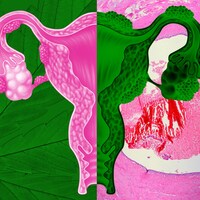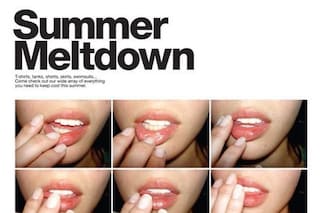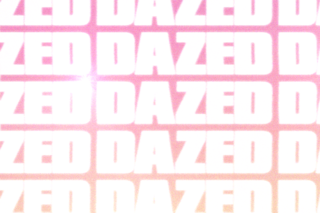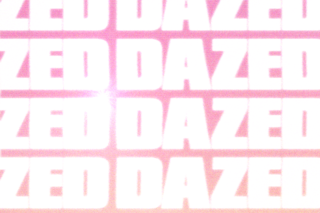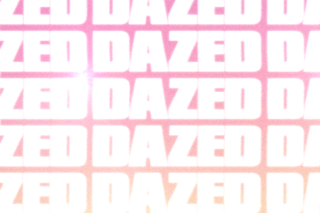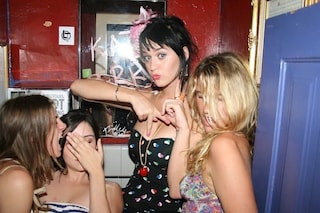With the aesthetics of the 90s and early noughties making a comeback, are we also witnessing a return to the glorification of thinness and glamorisation of drugs?
In the early 90s, the fashion industry was dominated by waifish models with pale skin and dishevelled hair. Led by a young Kate Moss and Jaime King, and documented by photographers like Davide Sorrenti and Corinne Day, the trend was controversially dubbed “heroin chic”. It epitomised the decade’s grunge-inspired nihilism, which served as a pushback against the glossy excess of 80s hedonism. The aesthetic is widely considered to have come to an end with the death of 20-year-old Sorrenti in May 1997. Soon after, the fashion industry banded together to condemn the look and models like Gisele Bündchen, tanned and athletic, rose to prominence, with Vogue proclaiming the “the return of the sexy model” and “the return of the curve”.
Despite this declaration, thin bodies remained a mainstream ideal for another almost two decades, enduring through the shifting aesthetics of Y2K, Indie Sleaze, and Twee. In the early 00s messaging promoting unhealthily thin bodies was rampant on largely unmonitored online forums and communities like Tumblr. With the prevalence of pro-ana (pro-anorexia) content, and the glamorisation of depression and drugs, in many ways the Tumblr girl was just heroin chic repackaged for teens. G-Eazy infamously paid tribute to the aesthetic in his 2014 song “Tumblr Girls” which opened with: “I’m in love with these Tumblr girls / With skinny waists and drug habits”.
It wasn’t until the 2010s that standards changed as “Kardashian” curves became sought-after, the body positivity movement gained momentum, and the wellness boom saw glowy health become a status symbol. For a moment it seemed like the industry had reached a point where it was finally ready to embrace a wide diversity of body types. However, now, as we witness the trend cycle churn its way back through 90s and early 00s culture, as low-rise jeans, under-eye bags, and smoking make a comeback, are we in danger of returning to the thin body standards that toxically impacted a whole generation the first time around?

It’s unlikely articles or trend forecasters will declare the return of heroin chic in the same way as the more palatable trends that succeeded it, but nevertheless, its influence has begun. “Smoking is back,” wrote the New York Times last month, reporting that in 2020, for the first time in two decades, cigarette sales had increased. Meanwhile, TikTok has declared BBLs (Brazilian butt lifts) over, if you believe the many videos zooming in on the Kardashians’ behinds to show a seeming reduction in size as the sisters go through their Indie Sleaze phase. On the runway, low-rise, micro-minis and cut-outs reign supreme, while in print, Robert Pattinson looks worse for wear on the cover of British GQ. On-screen, Euphoria’s chronicling of drug-tainted teenage angst recalls 90s movies like Kids and Basketball Diaries, with the show’s main character Rue and handsome newcomer Elliot perhaps pop culture’s most mainstream heroin use.
The trend has reached the beauty industry as well. According to the kids, dark under-eye circles are cool again, and a TikTok tutorial demonstrating how to fake it using concealer has been watched eight million times. Trend forecaster The Digital Fairy recently predicted we’d soon be in the “post-wellness party girl beauty” phase of skincare. “Skincare is very entwined with the concept of wellness, especially in recent years,” she explains. However, now we are witnessing the “indie sleazification of skincare,” as brands like 4.a.m and Bad Habit rebel against and subvert these Goopified wellness ideals. “The focus [is] on living less rigid lifestyles… staying out all night, drinking and eating food that’s not healthy.”
“In January 2022, Beat provided the highest number of support sessions for people affected by eating disorders in a single month in its history.”
This cultural shift has already begun to permeate our brains. On TikTok, users have expressed concerns about growing pro-ana content on a platform already rife with it and ED (eating disorder) online support groups have documented a significant rise in members. Holly, who at 25 is an older Gen Z, can attest to that personally: she says she and “at least five” of her close friends have “joined therapy or formal support for eating disorders in the last six - 12 months.” Lockdown was “definitely” a trigger and so too was the reintroduction of Y2K. “Especially the celebration of thinness and using thinness as an accessory,” she says. TikTok’s algorithm has been showing her “skinny, predominately white, girls eating the equivalent of a toddler’s diet” for months.
Lara, 21, joined an eight-week support group towards the end of last year, after a four-month wait due to a surge in people seeking help. She says despite losing her period and perpetually having no energy, she didn’t realise she had a problem because she saw similar bodies all over the media. “TikTok showcases regular people with so-called ‘aspirational’ bodies doing normal things, like dances and making recipes, which makes it easy to slip into the mindset of thinking you should also look like that. In reality, one of the reasons they’re popular is because of their physical appearance.”
ED clinics, too, have reported an increase in people seeking help in recent months. In January 2022, Beat provided the highest number of support sessions for people affected by eating disorders in a single month in its history, a seven per cent increase from the same time period last year. “It is generally now widely accepted that the media, and social media in particular, can precipitate or feed into poor mental health and disordered eating,” says Dr Heather Naylor, Clinical Director at The London Centre for Eating Disorders and Body Image.
@wannabehayleywilliams We still have time, audio still has less than 550 videos under it. #tumblr #2014tumblr #aesthetic #twee ♬ Why Do You Let Me Stay Here? - She & Him
As expected, messages through fashion, too, are triggers. "Harmful fashion trends, particularly during the 2000s, are often engrained in diet culture and encourage an infatuation with weight loss,” adds Tom Quinn, Director of External Affairs at Beat. “If a glorification of this era were to become prevalent in the mainstream media again, it would be very harmful for somebody who is susceptible to an eating disorder and could contribute to an eating disorder developing."
Millennials know this cycle all too well. When heroin chic was first prevalent, 28-year-old Ellen says she “loved” Kate Moss and was “obsessed with” Amy Winehouse. “The Tumblr aesthetic turned into another weapon in my internal arsenal,” she explains. “Not only was I depressed, but I wasn't the right kind of depressed, so I tried desperately to align myself with what I saw. America's Next Top Model, high fashion magazines, runway shows, and music videos – especially Lana del Ray – showed me that to be cool and successful you had to be thin.”
“I’ve definitely noticed there’s a huge promotion of thinness in pop culture and on social media right now and far less bigger bodies on show,” adds fellow millennial Lily. “This time, I at least feel like I have the tools to understand it’s misogynistic bullshit and that I don’t need to look a certain way. But at the same time, I can’t help but feel body conscious because I don’t look good in any of the currently trendy clothes. They’re simply not made for my size 14-16 body.” Lily seems to be onto something: brands like Revolve appear to have drastically reduced the number of diverse bodies on its site and others online have reported struggling to locate plus-sized items at their local H&M and Primark.
“We’re finding it hard to get curve models across the line at this time,” a trend director at a popular high street retailer tells me anonymously over Instagram, noting her work’s Pinterest board has been “algorithming to old runway photos” from the Kate Moss era. “Bodycon dressing lends itself to curves,” she continues. “But with trends moving more towards low-rise, midriffs, and separates, a lot of people in the company feel it just doesn’t suit that shape.”
Of course, until we stop buying into bodies as a trend, this cycle will continue. “The sad fact is, bodies have always been a means to make money,” says recovering Tumblr girl Jemma. Everything is sold back to us and what better way to sell products than to make people feel bad about themselves. “There will always be a body type that is ‘in’ or ‘out’ – and I have no idea how we will ever move away from that in our culture.”
Like Jemma, Ellen went through years of therapy to unlearn her disordered eating habits and recently has begun to have to implement measures to protect her mental health again: logging off, speaking to professionals and reporting any triggering content she sees. “As a society, we've only now really started to heal and grow from the excessive skinniness of the heroin chic and Tumblr era,” she says. “I really hope it stays in the past.”
If you’re worried about your own or someone else’s health, you can contact Beat, the UK’s eating disorder charity, 365 days a year on 0808 801 0677 or through online chat here, or The London Centre on 020 3137 9927.
